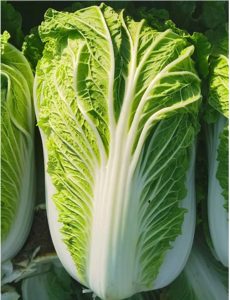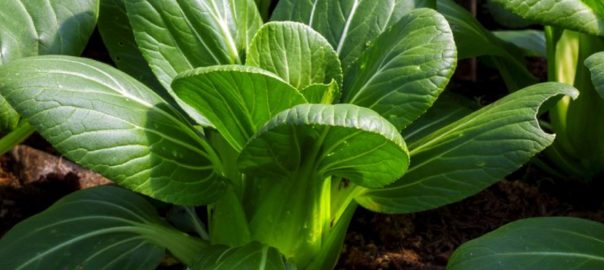April 2024 Grow Me Now – Asian Greens
A word of caution: (animal manures, compost, vermicast, and soil in general, can pose serious health risks. Learn how to use these garden additives safely before you begin working with them, especially when using them to make liquid manure plant feeds).
Asian Greens – Made for Autumn!
Autumn offers an exciting window of opportunity for growers, and for anyone who didn’t manage to get their soil into shape for spring and summer, it’s the perfect time to develop a tunnel house salad and greens garden. The term ‘Asian greens’ encompasses a wide range of crisp, tasty vegetables that grow rapidly and lend themselves to a quick turnaround crop that can be harvested in time to make way for a later batch of more traditional brassica. Some of the easiest Asian vegetables to grow include mibuna, mizuna (red and coral), tat soi, choi sum (green and purple stemmed), shungiku, a wide range of pak choi, broccoli Chinese gai lan, and red and green mustard. Hearting varieties of Asian greens, such as Chinese cabbage, along with large winter radishes (such as daikon), are prone to running to seed should a warm spell arrive, and are best grown outdoors.

Ground work
Make no mistake about it, Asian greens are wonderful performers, often harvestable in as little as 4 weeks, with many being ‘cut and come again’ vegetables. But, that said, they will quickly run to seed if they are not given first class treatment, and that begins with soil preparation.
Summer edibles have by now spent months in the tunnel house, and by April will have thoroughly depleted the soil you prepared for them back in September. Not only that, but as you have tapered off watering to assist with the ripening of fruit, the ground these plants have relied upon will be open and dry. Remove their spent summer growth, and before you replace them with anything else, water the ground deeply.
Deep watering involves applying a steady, light stream of water to the ground in an unhurried way, or turning on the sprinkler for half an hour or more. You can use a watering can for the job if you have strong arms. As a guide, use no less than 10 litres (two full, average-sized watering cans) of water for every half square meter of ground. Allow the moisture to seep in, then return 30 minutes later to repeat the treatment. Leave the soil overnight, then water once or twice again.
The greatest cause of Asian vegetables running to seed is lack of moisture, so to create an environment that will hold it in, while still being free draining, you will need to apply lashings of humus-rich compost (3-4 household-sized buckets per half square meter is not overdoing it). If your compost does not include aged animal manure, you will also need to scatter some of this onto the tunnel house beds at the rate of 1-2 buckets full per half square metre Once you have assembled your ingredients, fork everything together well, and water deeply one more time.
Next, prepare a concentrated liquid feed by soaking together for a week, in equal quantities, the following: chopped seaweed (seaweed extract can be purchased from the garden centre if you cannot lay hands on kelp), shredded comfrey leaves, and mature compost and/or vermicast. Dilute at a rate of 1 to 4 for use as liquid manure feed.

Sowing and Transplanting
All Asian greens are best grown in-situ, but you can get away with carefully transplanting many varieties (read seed packets for instructions). In general, avoid transplanting mibuna and mizuna to prevent it running to seed, and instead, sow it thickly as you would mesclun mix (aiming to have seeds fall just a few millimetres away from each other). Bearley cover with sieved soil. Sprinkle with water.
Other Asian greens can be transplanted, using a dibber, around a hand’s space apart. These tender greens are easy prey for slugs and snails, so if you are not prepared to pick the beasties off after dark with the help of a torch, scatter low-hazard slug and snail bait around the plants, and keep children and animals well away from the area at all times.
Maintenance
You are aiming to have your Asian greens grow as rapidly as possible. To encourage this, keep the soil damp, but not moist, by watering in the morning so that leaves are dry by nightfall. Where safe to do so, apply liquid feed once a week, ensuring it does not touch the edible parts of any plants. To encourage warmth, but not too much (Asian greens prefer temperatures in the range of 13 to 18°C) open vents and windows during the day and close them up again at night. On warm days, leave the door of the tunnel house open as well, to allow air to circulate, but cover the opening with mesh (or invest in a screen door) to keep out birds and animals. Close again at the end of the day.
Tips:
Harvest greens according to instructions on your seed packets, bearing in mind that is often not necessary to cut off an entire plant at the base. Rather, individual leaves can be harvested, extending the life of the vegetable.

When your greens eventually begin to bolt (run to seed) make use of their pretty flowers by using them in stir fries, salads, rice paper wraps, and dumplings.
Over-mature Asian greens can still be eaten if you are prepared to peel stems. In fact, celtuce (Chinese stem lettuce) is grown specifically for its crunchy thick stem.
When using is salads, go easy on the mustard green (save them for your kim chi and other pickled Asian green recipes).
as soon as they are a suitable
